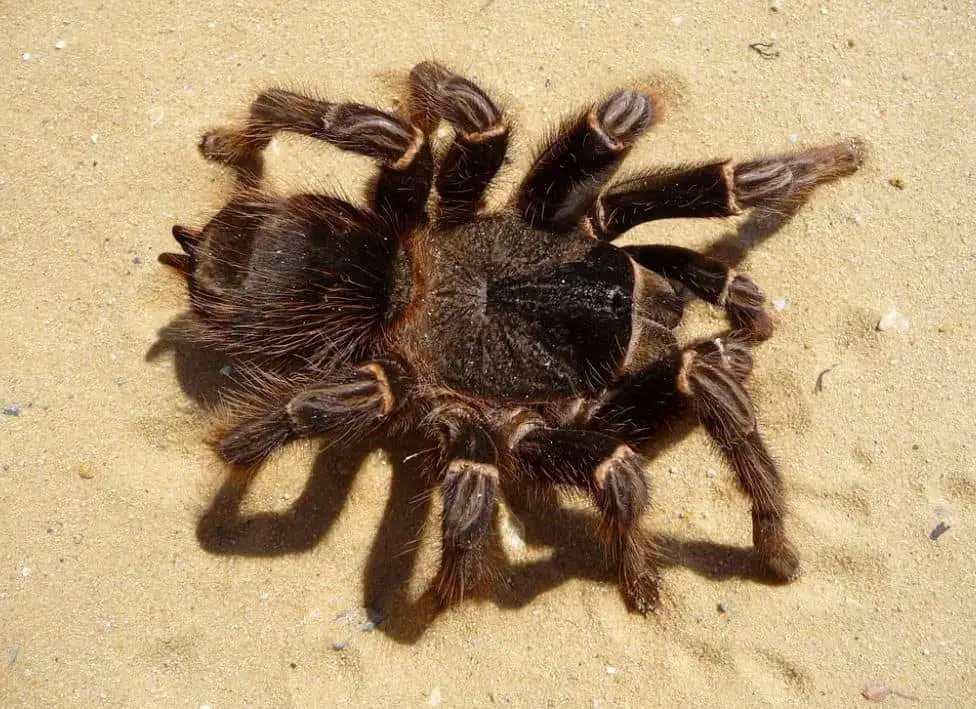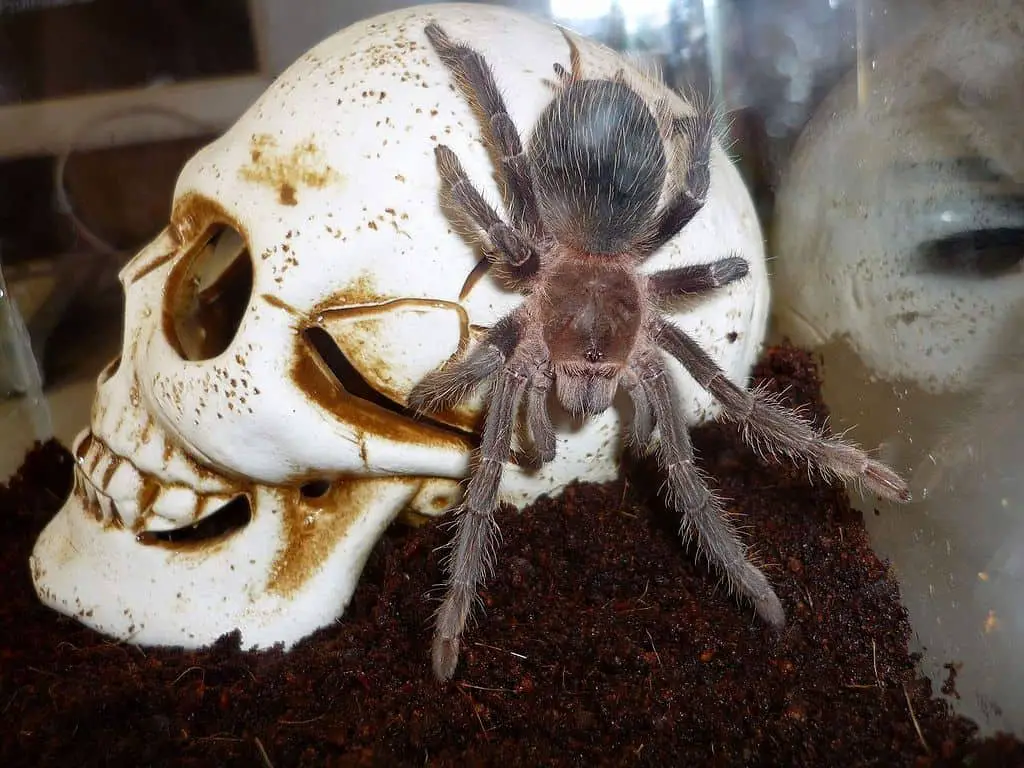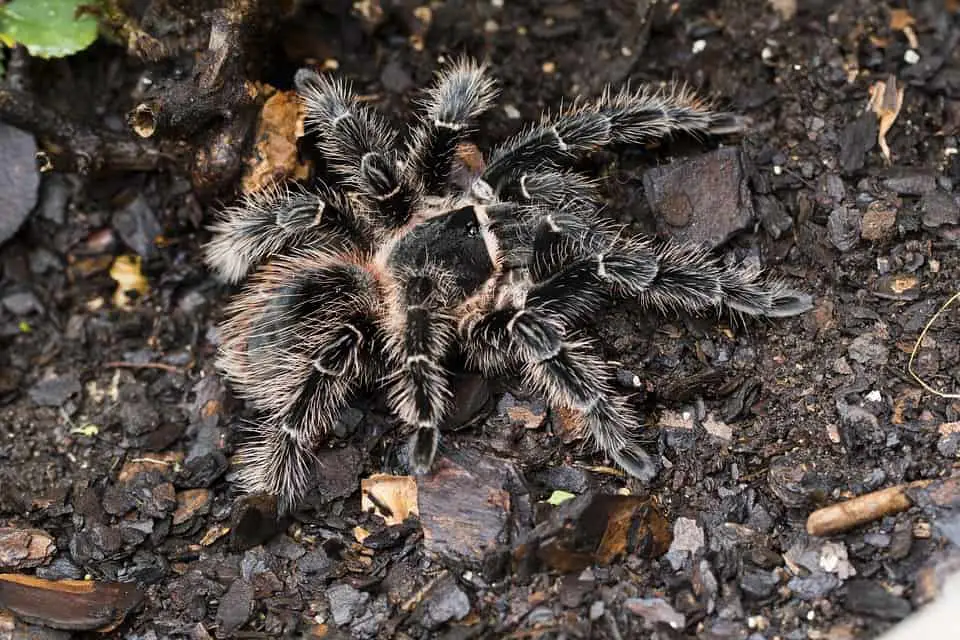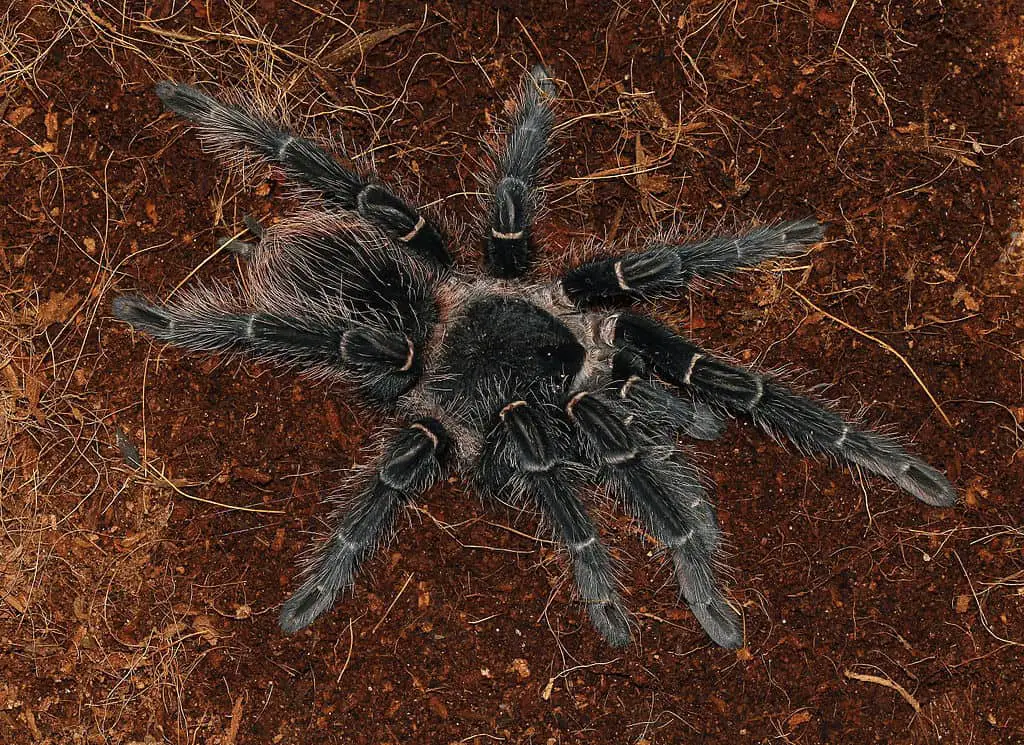The Salmon Pink Birdeater Tarantula (Lasiodora parahybana) is a massive New World terrestrial tarantula. They’re native to Brazil and can grow to an impressive 11 inches in size. They’re mostly known for their giant size but are also famed for their beautiful pink hairs giving them a unique appearance.
Their docile nature, impressive size, and remarkable appearance have made them very popular among hobbyists who often get them as display spiders.
If you’re considering adding this species to your collection, here is everything you need to know!

Salmon Pink Birdeater Care Sheet
| Species Name | Lasiodora parahybana |
| Family Name | Theraphosidae |
| Common Names | Salmon Pink Birdeater Tarantula |
| Category | New World |
| Type | Terrestrial |
| Native Location | Brazil |
| Leg Span | 11″ (~27.5 cm) |
| Growth Speed | Fast |
| Urticating Hairs | Yes |
| Social | Solitary |
| Diet | Crickets, roaches, mealworms. Also small mammals/lizards in the wild. |
| Temperature | 70 to 80 degrees Fahrenheit |
| Humidity | 70 to 80% |
| Lifespan | Female: 15 years / Male: 5 years |
| Experience required | Beginner |
| Minimum tank size | >10 gallons. 24″x18″x12″ |
Salmon Pink Birdeater Tarantula Overview
The Salmon Pink Birdeater is a tarantula species that is native to north-eastern Brazil. They live on the floors in the rainforests where they burrow into the ground. They use their silk to create a web that acts as a sort of tripwire in front of their burrow that notifies them when prey is nearby which they then ambush with their inch-long fangs.
They’re known for their incredibly large size and are the 4th largest tarantula species in the world, second only to three species in the Theraphosa genus.
Appearance & Varieties

The Salmon Pink Birdeater gets its name due to its coloration. They’re black in color and as they become adults they develop pinkish hairs along their legs and abdomen giving them a very unique appearance.
These spiders are dimorphic which means that males look different than females. As is the case with most arachnids, females are significantly larger than males. Especially the abdomen and carapace of females are substantially larger. Males typically have a slimmer body type with longer legs and more vibrant colors.
These spiders are true giants. They can reach a leg span of up to 11 inches putting them firmly in the category of huge tarantula species.
Price
Salmon Pink Birdeaters are usually not very expensive. You can buy a sling from a reputable online vendor like FearnotTarantulas or JoshsFrogs from $25 to $50.
Older specimens are typically more expensive and females are often pricier than males due to their long lifespan. Nevertheless, since these spiders are not very rare and are in high demand among hobbyists means that there are plenty of breeders that sell even adults for relatively cheap prices.
Behavior & Temperament

The Salmon Pink Birdeater Tarantula is generally described as being docile. They’re not very defensive and their first instinct is to try to flee rather than fight.
Nevertheless, if this species feels threatened they will assume a threat posture where they raise their front legs and show their fangs. This is a warning to not come any closer. If that does not deter the threat from leaving them alone they will release their urticating hairs.
The Salmon Pink Birdeater’s urticating hairs are quite uncomfortable when they land on your skin and if you get them in your mouth, eyes, or nose, it’s even worse. Always make sure that you wash your hands after being in close contact with these spiders to avoid accidentally transporting these barbed hairs into vulnerable spots on your body.
If their urticating hairs are not enough to deter a predator they will bite. While they do not bite unless absolutely necessary, their bites are no joke. They have long fangs that can do quite a bit of damage. Luckily, their fangs are more threatening than their venom. They do have venom, but it’s not very potent.
The Salmon Pink Birdeater is not a shy species and she does not mind spending quite a bit of time out in the open. This, combined with her large size and unique appearance and coloration make her very suitable as a show spider. Furthermore, their docile nature also means that they’re quite suitable for beginners.
Handling
Tarantulas honestly do not get much out of being handled by humans. They’re not cats or dogs that crave affection or attention. It’s more the case that the human owners enjoy handling their spiders.
Due to their docile nature, the Lasiodora parahybana can indeed be handled, but you do have to be careful, not only for your own sake but also for your spider’s sake.
When handling them it’s recommended to wear gloves since their urticating hairs are so potent. Also, if you do plan on handling them be very careful not to drop them. These spiders are incredibly large and heavy. They can weigh over 100 grams so even a small drop can cause their abdomen to burst which can easily lead to their demise.
Caring for a Salmon Pink Birdeater Tarantula
Did you know that tarantulas can go for months without eating? Of course, that doesn’t mean that you should leave them without food for months but it goes to show that these animals are truly low-maintenance pets.
As long as you provide them with a proper habitat, food, and water they’ll be able to thrive.
Of course, there are a couple of things that you need to know in order to provide that for them.
Tank setup
Salmon Pink Birdeaters are large spiders. As such, they need a relatively big enclosure. Since they’re terrestrial borrowers, they need an enclosure that’s more wide than tall. A good size to shoot for is at least 10 gallons. However, too big is also not necessary since tarantulas are very docile animals that do not move more than necessary.
When selecting an enclosure, important things to look for are cross ventilation and
A good enclosure for them is the Exo Terra 24x18x12 because it can provide
Of course, slings and juveniles do not need such a large enclosure. They will do just fine in smaller spaces as long as you grow their tank size as they get bigger.
Even though the Salmon Pink Birdeater is a burrower, you can also provide them with a hide to give them more options on where they want to go.
To decorate the tank you can place some artificial plants and natural rocks around the place.
Substrate
Salmon Pink Birdeater Tarantulas are terrestrial and like to burrow so they should have a layer of substrate that’s deep enough to facilitate this behavior. Make sure that their enclosure contains at least a 4-inch deep layer of substrate, and ideally more than that.
Coconut fiber is probably the best substrate to use, but bagged topsoil can also work. Many owners also report success with a mixture of coco fibers, vermiculite, and peat moss.
To keep the humidity up, you can also place some sphagnum moss in their enclosure.
Temperature & Humidity
When keeping any exotic animal as a pet it’s always a good idea to try to closely simulate their home temperature and humidity. After all, this is what they’re most adjusted to.
In the case of the SPBT, this is a rainforest climate which means that it’s quite warm and humid. Temperatures between 70 and 80 degrees Fahrenheit are good for them and humidity should ideally be kept between 70 and 80% although they can also do fine in situations with lower humidity.
Many owners drip water down the sides of the tank. This is done so that the substrate becomes moist in layers; the bottom layer will be more moist than the top.
Social
The Salmon Pink Birdeater is not a communal spider so they should not be housed with other members of their species. In the wild, they meet solely with one another when it’s time to breed. If you try to house more than once in the same tank it will likely end in cannibalism.
Molting
The Salmon Pink Birdeater grows to an incredibly large size very quickly. As a result, they molt quite frequently, especially when they’re young.
If they refuse to eat for a few days it’s often a sign that they’re in pre-molt and about to start the molting process. During the molting process try to leave the spider alone as much as possible to avoid unnecessarily stressing them out.
Once the molt has completed they should not be fed for several days because they need time for their fangs to harden enough to eat prey.
Diet & feeding

Salmon Pink Birdeaters have an appetite that matches their size and should eat quite a bit. However, despite their name, you should not try to feed them birds!
Slings should eat pre-killed small crickets or flightless fruit flies until they’re about half an inch in size. At that point, you can start feeding them one small cricket once or twice a week until they’re ready for their first molt.
Juveniles should eat around 3 medium crickets a week and adults should eat 8 to 10 large crickets every 7 to 14 days. You can also feed them other insects such as Dubia roaches, super worms, or mealworms.
Some owners feed their birdeaters small rodents or lizards and while they’re definitely capable of eating those, they’re perfectly capable of living on just insects.
The amount you should feed your spider is never set in stone. The amount of food they need depends on their size, activity level, sex, and age.
Keep an eye on their abdomen to judge whether you’re over or underfeeding them. If the abdomen is getting larger, you might need to tone down their food intake a little. If it’s shrinking, you might be underfeeding them.
Health & Lifespan
Salmon Pink Birdeater tarantulas are generally quite healthy and hardy. In the wild, they do have their predators, but in captivity, there’s not much that prevents them from reaching their maximum lifespan of 15 years for females or 5 years for males.
The main things that are a threat to them in captivity are mold growth, spider mites, and parasites. Luckily, those are quite easy to avoid. Make sure that you remove uneaten food, clean their enclosure when needed, and do not feed them wild-caught insects.
Another common threat to these massive tarantulas is falling. You can prevent accidental falls in their enclosure by making sure that the enclosure is not too tall so that they can not climb high enough to injure themselves. Also, when handling them, you have to be extremely careful not to drop them.
Salmon Pink Birdeater Tarantula facts
- This species was first described by Cândido Firmino de Mello-Leitão in 1917.
- They’re the fourth largest tarantula species
- Males have tibial hooks to prevent the female’s fangs from impaling them while mating
- Their fangs can be over an inch long
- Females often eat males after breeding, they will even chase them in order to do so. Males sometimes get away, but they’re not always so lucky
- They’re much cheaper than other large tarantulas such s the T. Blondi because they produce massive numbers of offspring. One egg sac can have between 1000 and 3000 eggs!
Final words: Is the Salmon Pink Birdeater the right Tarantula for you?
The Salmon Pink Birdeater is a massive spider with a black body and unique pinkish hairs. They’re not shy and have a tendency to sit in the open in their enclosure. This, combined with their docile personalities has made them fan favorites among the tarantula community.
Whether you’re new to the hobby or have already owned dozens of spiders, the SPBT is a species that’s a must-have for any true collector.
- How Long Do American Eskimo Dogs Live? Important Factors and Care Tips - September 29, 2023
- Do American Bulldogs Need Grooming? Essential Tips and Care Guidelines - September 29, 2023
- Do Bengal Cats Enjoy Playing? Essential Tips for Keeping Them Active - September 29, 2023